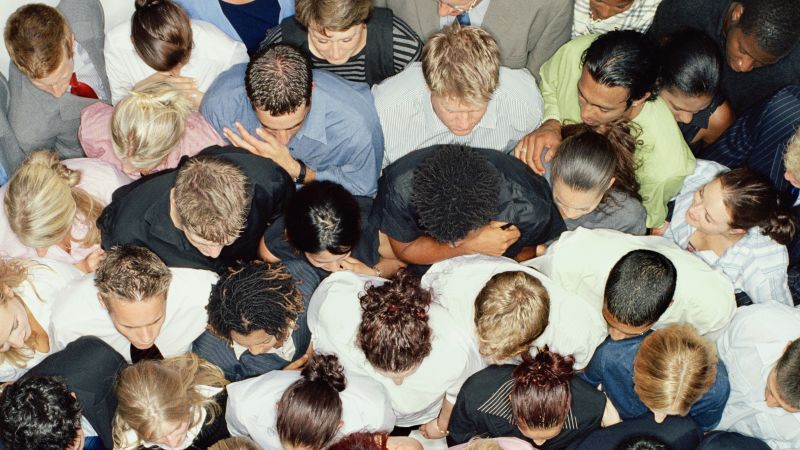Experts say it’s less risky to catch Covid-19 than it used to be, but there are still good reasons not to treat it casually.
Covid-19 was never just another cold. We knew it was going to stick around and keep changing to try to get the upper hand on our immune systems.
But we’ve changed, too. Our B cells and T cells, keepers of our immune memories, aren’t as blind to this virus as they were when we first encountered the novel coronavirus in 2020. The US Centers for Disease Control and Prevention has screened blood samples and estimates that 97% of people in the US have some immunity to Covid-19 through vaccination, infection or both.
Then there’s science: We have updated vaccines and good antivirals to lean on when cases start to rise. Masks still work. Rapid tests are in stores. We now know to filter the air and to ventilate our spaces.
Those strategies, plus our hard-won immunity, had helped bring our national numbers of infections, hospitalizations and deaths down to levels that felt almost forgettable.
Almost.
Now that Covid-19 infections have started to rise again, it feels like people all over the country are testing positive, and it’s hard to know how to react. The government has been dialing back its response since the end of the public health emergency in May. Good Covid-19 data is hard to come by and harder to interpret.
So if people are less likely to be hospitalized or die from a Covid-19 infection now, has the danger passed? Is there still reason to worry if you do catch the infection for a second, third or fourth time?
Experts say it’s less risky to catch Covid-19 than it used to be, but there are still good reasons not to treat it casually.
“At this point, the risk is lower because of our prior immunity, whether for severe outcomes or for long Covid,” said Dr. Megan Ranney, an emergency physician and dean of the Yale School of Public Health.
“Covid is still more dangerous than the flu, but its level of danger is becoming less,” she said, noting that we’re still very early in our human experience with the coronavirus, even four years in, and there are still things we don’t know.
“But for it to behave like other respiratory viruses in terms of seasonality and surges is entirely expected,” she added.
It would be “really weird” for Covid to disappear or for it not to cause illnesses, hospitalizations and deaths. “It is still a virus,” Ranney said.
But a somewhat predictable waxing and waning of infections doesn’t make Covid-19 something to turn our backs on.
Our immune systems are better at spotting danger
After more than three grueling years, nearly all Americans have some immunity against Covid-19.
That means our immune systems – as long as they’re healthy and working as they should – will remember most forms of the coronavirus when it next comes our way.
That process takes some time to get going, however. That lag may give the virus enough of a window to get a foothold in our nasal passages or lungs, and we get sick. We may feel crummy for a few days, but then our B cells and T cells get their antibody production up and running. Eventually, they shut the virus down, and we get better.
That’s what should happen. But for many, their immune system just doesn’t kick in as quickly or as vigorously as it should.
Immune function drops off naturally with age. About 1 in 4 Americans is over the age of 60, according to census data. Then there are certain medications and health conditions that suppress immune function. About 3% of the U.S. population – 7 million people – is severely immunocompromised, according to the National Institutes of Health. This is a group taking medications to protect organ transplants or who are getting powerful drugs for cancer treatment, for example.
Then there’s individual variability. Through genetic bad luck, some people may just be at higher risk of serious reactions to Covid-19 infections, and they probably wouldn’t know it.
Taken together, that’s a sizeable pool of people who benefit greatly from having antibodies at the ready to take on the coronavirus as fast as possible. Vaccines get those antibodies in place and ready to work as soon as they’re needed.
Sometimes, people are so immunocompromised that vaccines can’t help them much, either. They benefit from preventive shots containing Covid-fighting antibodies that are built to stick around the body for a few months. Until this year, there was such a preventive product available, Evusheld. But the virus has evolved so much that Evusheld lost its potency, and in January, the FDA revoked its authorization.
Since then, people who have very low immune function haven’t had anything to protect them from infection or severe disease. But that could change. The government announced this week that it’s funding the development of a new preventive antibody through the drug company Regeneron. Trials of that drug are expected to start this fall, according to the US Department of Health and Human Services.
While nearly all of us have immune systems that can recognize key parts of the virus now, even that memory to the infection fades over time. The longer it has been since you’ve been infected or vaccinated, the more forgetful your immune system becomes.
Those B cells and T cells, “they’re going to be a little slower to respond. They’re not they’re not as primed and ready to go,” Ranney said.
Your strongest immunity will be in the two weeks to two months after you get your vaccines. That means it’s smart to try to get your shots shortly before Covid is expected to be on the upswing. Just like for flu, experts expect the worst of Covid to hit in the fall and winter.
CDC Director Dr. Mandy Cohen said that even though cases are going up now, most people will be better off waiting a few weeks to get the newly updated Covid-19 vaccines rather than trying to get one of the older bivalent vaccines right now. But this is dependent on personal risk, so if you’re concerned, talk to your doctor or nurse practitioner about your options.
Risks from new variants
Variants are another reason people need to keep getting Covid vaccines. The coronavirus evolves constantly. Most of the time, its improvements are incremental. In essence, it slips on a hat or fake mustache, but that’s not enough to completely disguise it from our immune system or our vaccines when it tries to break in.
Occasionally, it gets a makeover. It has cut and dyed its hair, had plastic surgery and lost a ton of weight, so to speak. These big changes make it unrecognizable to our immune system and sometimes to vaccines and drugs we use to fend it off.
That happened during the first wave of Omicron. A virus emerged in South Africa and Botswana that was wholly different from the viruses in circulation but still caused Covid-19. It quickly spread worldwide, infecting vaccinated and previously infected people alike. Omicron caused a jaw-dropping 1 million infections a day in the United States in the winter of 2021.
Another virus like that has emerged on the world stage. It’s called BA.2.86, and it has more than 30 amino acid changes to its spike protein, which makes it as genetically distant from its next closest ancestor – BA.2 – as the original Omicron variant was from the ancestral strain of the SARS-CoV-2 virus that emerged in 2019 in China.
Compared with the very first sequences of the virus that causes Covid-19, it has 58 changes to amino acids in its spike protein, according to Dr. Jesse Bloom, who studies the molecular structure of viruses at the Fred Hutchinson Cancer Center in Seattle.
It’s not clear exactly where BA.2.86 came from. Scientists believe that the pattern of mutations it carries are characteristic of a virus that’s been changing inside the body of a chronically infected person. Typically, these patients have diminished immune function so that they can’t completely clear the virus from their bodies, but they have enough immunity that it puts pressure on the virus to keep changing to survive. Or it may have previously circulated in a part of the world with limited variant surveillance.
Scientists have spotted 13 human infections with this emerging variant have been confirmed from six countries: Israel, Denmark, the United Kingdom, the United States, Portugal and South Africa. The status of the patients is not known in every case. Of the cases for which information on the patients is available, one has been hospitalized, and none have died.
he people do not appear to have had contact with each other, and only one has traveled, indicating that the variant is present around the world and spreading in the community – though it is not known to what extent.
It has also been picked up at very low levels in wastewater in the US, Switzerland, Denmark and Thailand.
It is also not clear whether this virus will outcompete other circulating variants and grow to cause widespread infections. Variant hunters around the world seem to have spotted it early.
Researchers are studying whether it will be able to evade immunity from past infection and vaccination. More information should be available within a few weeks.
Unfortunately, the fact that the new coronavirus can morph this way means we’ll probably need to keep updating our vaccines and our immunity to keep pace.
The US government has launched Project NextGen, which aims to create longer-lasting and more variant-proof vaccines. The first clinical trials of those new vaccines are expected to start this winter, HHS says.
…
archive link: https://archive.is/OYOB6



Most people will read the first part of the highlighted subtitle and move on to the next social media thing thinking, see, it’s pretty much over now. It’s never going to be over, it’s just not quite as bad as it was when we didn’t have anything to fight back with. “Still more dangerous than the flu” should be highlighted as well, and while it’s not a huge percentage people do die from the flu, and the actual flu (not the cold that people think is the flu) is nasty to get even if you aren’t at risk of dying.
We continue to do everything either wrong, or barely minimum to say we’re doing anything. Any wonder why so many are sick with persistent symptoms? (but have to get back to
spreading it morework anyway because America and The Economy)There’s no political or social will for mass community measures. It would take a 1000 percent uptick in deadliness before we could even begin discussing sweeping shutdowns and masking. Like it or not, reality is that we can only do what we can on a personal level.